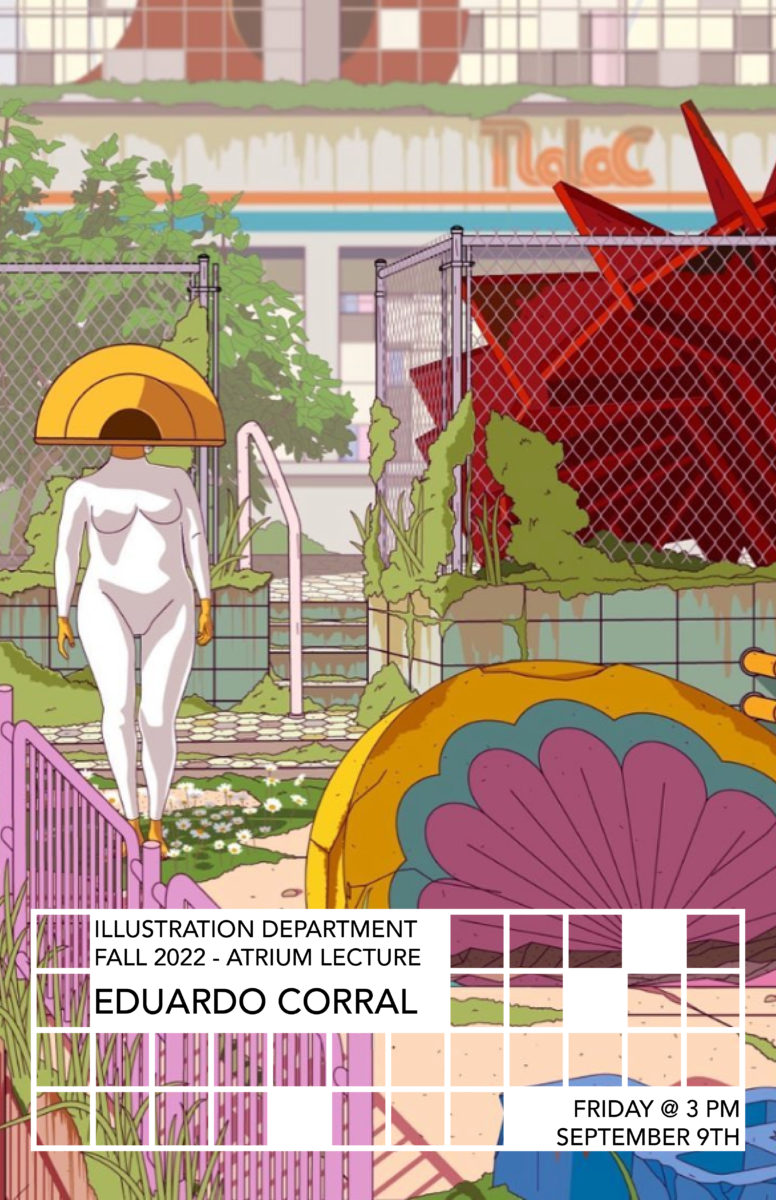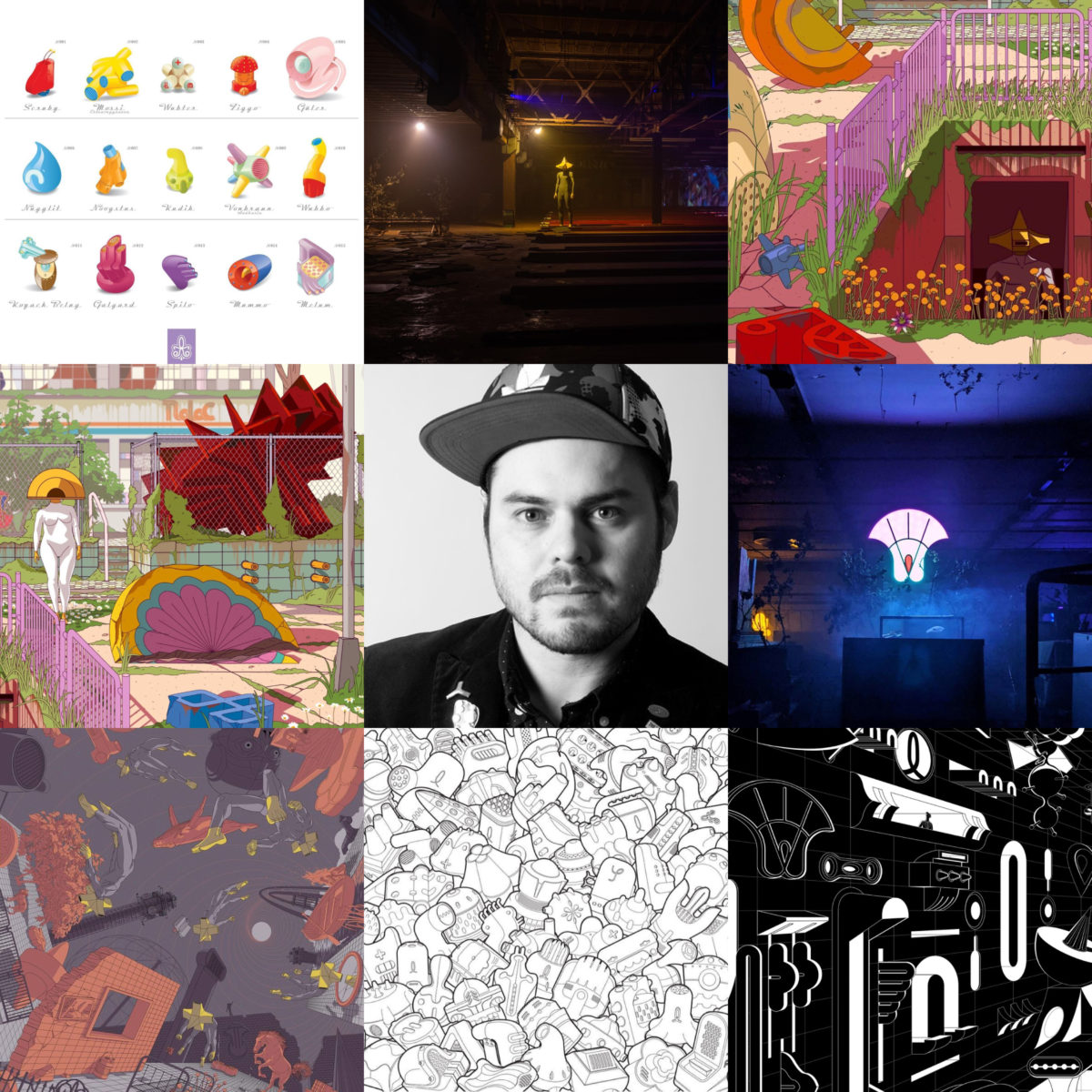
Illustration: Multidisciplinary artist TLaloC visits PCA&D Sept. 9
Wednesday, September 7th, 2022
The artist TLaloC, who also goes by his given name, Eduardo Corral, is a multidisciplinary artist whose work can be hard to pin down to a single medium — or even multiple mediums. Illustration and design, he says, were his “first loves,” and they continue to inform and shape the path that has forked into his current interests: sculpture, installation, product design, architectural landscaping, film, music — and many, many others.
“Illustration is the pivotal discipline where all of my interests converge,” TLaloC says, “but I consider this discipline a vessel or vehicle for more complex conversations. Almost all my illustrations serve as containers for the three-dimensional world that I later propose in my work as a sculptor. My most recent illustrations are usually architectural landscapes with painstaking detail where I capture and shape elements that subsequently take a tangible form.”
TLaloC will be a guest of the Illustration Department Friday, Sept. 9, at 3 pm in the Atrium. The PCA&D community is welcome to attend the presentation by this prolific and wide-ranging artist:

Can you delve into your chosen name, TLaloC? When and why did you adopt this name?
TLaloC: My pseudonym, TLaloC, is just a nickname someone gave me and that I adopted later, circa 2009 or so. It is basically a wordplay for my short name: Eduardo = Lalo (like William = Bill), and the first letter of my last name, Corral. So Lalo+C sounds almost the same as TLaloC. What about the letter “T”? Well, that is a mystery. Not coincidentally, Tlaloc is the name of the God of Rain in the Aztec religion. Although I can say that I really like rainy days, the real reason for adopting this moniker has much more to do with the idea of hinting at my nationality in a more flagrant way … a fact of which I am infinitely proud.
The art and design world, in general, seems to like to pigeonhole artists and their work — do you find yourself being “branded” as a Latinx artist? If so, is that fair? Is that label liberating, or limiting, to you?
T: Funny enough, the inherent Latinx brand or aesthetic in my work has gone completely unnoticed (or misunderstood) and is practically invisible to the viewer. I say the latter because most of my work is directly influenced by the particular aesthetic of my hometown, Monterrey, Mexico, an industrial city located about three hours from Texas.
I spent most of my childhood living in areas surrounded by monumental factories. The places where my family lived were located near metal foundries and aluminum, paper, soap, chemical, and cement plants. The urban landscape of this treeless city is heavily defined by gigantic exhaust pipes, towering metal structures, high-tension towers, steam whistle sounds, and the smell of molten iron, rust, and chemicals. This is the Mexico I portray in my work.
I honestly find this unexpected occurrence absolutely positive and extremely liberating, as it has allowed me to develop a universal visual language while allowing me to remain as anonymous as possible. This is why my pseudonym, TLaloC, functions as a branding effect, and a perfect placeholder of my true persona.

All work by TLaloC.
You’ve talked in past interviews about your fascination with the unknown … can you explain that?
T: That statement is specific to my ongoing artistic production, “Elgreen Project,” which is based on the obsolescence of forgotten everyday objects and the loss of meaning they suffer when they “disappear” from a given current context.
I have developed an extreme interest in any kind of unidentifiable manmade object that serves as a tangible link to an era in the distant past, from which time has erased any trace of its true purpose. As an unavoidable consequence, I’m equally interested in the inevitable human act of seeking answers and clues to unravel and rediscover its mysterious specificity.
Similarly, I have a fascination with lost or extinct languages, indecipherable documents, and unexplained events that spark the imagination of the masses. The Antikythera mechanism, the Voynich Manuscript, the Rohonc Codex are just a few famous examples of mysterious artifacts and relics that reflect my interest with the unknown.
What sparks you in your creative life when you hit a snag or dry spell? Do you have a way of pulling yourself out that often works?
T: As illustrators or creative individuals, we must not forget that our perception of things is very different from that of others; so, consequently, we must always be aware of daily unassuming activities that could easily go unnoticed as part of our artistic sources. On many occasions, that is where “good art and ideas” hide.
For example: Do you cook? Yes? We, maybe that’s where your illustration or creative endeavors will find their full potential.
Like most creative individuals, I inform my work with inspiring resources like cinema, literature, music, etc. But I also learned to embrace the simple act of going for a walk, or a bike ride, carefully observing the world around me, with the intention to identify any messages hidden in the “ordinary” that could potentially be translated into my work. On many occasions I just go out with my phone camera ready, trying to find something that informs my work. It could be anything! An interesting building, a texture, a color combination, a person. As Bruce Nauman‘s neon sign artwork states, “The True Artist Helps the World by Revealing Mystic Truths.” Or at least this is how I interpret his enigmatic phrase.
